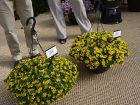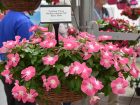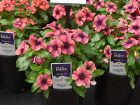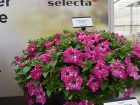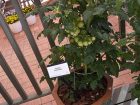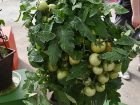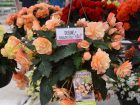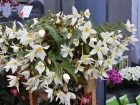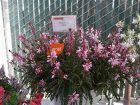
Features
New Varieties
Seeing new varieties with a trained eye
An experienced industry consultant shares his advice, thoughts, and picks of new varieties from this year’s California Spring Trials.
July 24, 2018 By Melhem Sawaya
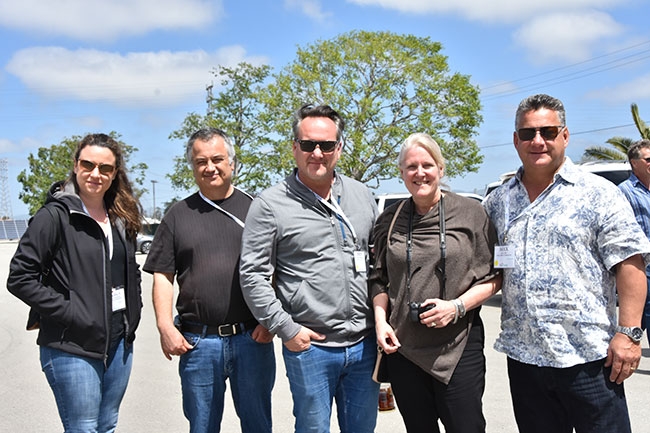 CAST is an opportunity for exchanging information among different groups, as evidenced here. Pictured: John and Cassia (Bonanza), Ron (George Sant & Sons), Judy (Canadian Tire) and Max (Ball Seed).
CAST is an opportunity for exchanging information among different groups, as evidenced here. Pictured: John and Cassia (Bonanza), Ron (George Sant & Sons), Judy (Canadian Tire) and Max (Ball Seed). The California Spring Trials (CAST) were started by Glenn Goldsmith in 1967 which was for the purpose of educating growers of their breeding programs and their commitment to horticulture, and then other breeders started to join in the event to include almost every horticultural breeder distributor. The name evolved from the ‘California pack trials’ to now ‘California Spring Trials’ since the packs are a very small percentage of the industry.
The California Spring Trials, which I prefer to call ‘California showcase’ since that’s what it is and no trials take place, is very interesting in the sense that you feel it is a must to attend. After the end of the tour you feel a ‘variety overload’ with an excitement to try many of the varieties that you saw. Then when you get home, you start reviewing the pictures, analyzing the whole trip and you end up trying two or three varieties – which is the right action. Try a limited quantity until you know the most effective growing practices, consumer response and garden performance in your area.
If you are visiting the trials for the first year, or if you skipped two years, then yes, you will still learn something new. The great benefit from visiting the showcase is to meet the people who you talk to over the phone, email for questions or inquire about a variety or a production question. Whatever the case is, communicating with a person that you have met face-to-face will always be better no matter how new the communication technologies get. Yes, networking is face-to- face communication – not on the internet. New technologies are great for communicating details and transactions, not for getting to know people and building lasting relations.
Less than 25 per cent of the California showcase participants are growers. The showcase is geared to buyers and specifically, brokers or chain buyers. Perhaps that is why the trial aspect disappeared or maybe the growers cannot find anything new for them to learn other than new colours and new cultivars that have not yet been tested.
I heard the same rumour this year that I heard last year, that all the breeders are working to have the California showcase in one large location to attract more visitors and to save themselves thousands of dollars. It is most probably a rumour because this will require cooperation, common sense and a change from the way we’ve been doing it all these years. And God forbid any change is a crime.
This, I have mentioned for the last four years covering the trials, but it is happening in a totally different way than how I thought it would. Companies are bought, amalgamated or making others disappear, which means fewer players and makes the showcase a little geographically closer.
Because most of the California showcase attendees are chain store buyers, many new cultivar exclusivity agreements take place between the breeders and chains. In many cases, once a new cultivar is introduced by the breeders, a chain will take that cultivar exclusively. In my experience, that process is the number one factor for shrinkage in profits for the grower and the chain, and it’s the best recipe for ultimately eliminating more customers because:
- It didn’t go through a garden performance trial
- No customer appeal study has been done
- The know-how to produce a top-quality product for a specific date has not been established
Normally, these exclusive products cost more to the grower. Once the breeder has sold the product to the chain, the chain puts the product on the front page of their promotional material – the most expensive section – and the store has to place the product in the most prominent display area. So the chain has spent a lot of money advertising a product the consumer may no longer buy. The chain’s credibility is diminished in the eyes of the consumer and, worst of all, the grower is left with product that costs a great deal to produce and must now incur even more costs to dump it…but not to worry, it’s all RECYCLABLE!
The consumer can be deceived only once and then we have lost him or her.
Increasing the consumption of horticultural product can only be done by helping the consumer be successful and satisfied with their purchase…not setting them up for failure.
This is the reason I share these varieties with you. They are meant to be trialed at your own facility so you know how to grow them, you can track consumer appeal and, last but not least, monitor their garden performance.
What is covered in this issue is only a sample of the hundreds of varieties that were shown at the California showcase. Many of the varieties are new introductions for 2019. Others are older varieties but with improvements or changes year-to-year while carrying the same name. Some others have been around for many years but new trends now make them an important variety to share with you or you may not have tried them before.
This is only a sample of the new varieties that we get bombarded with every season. Hopefully with the amalgamations taking place, we will see many cultivars disappear and selection of the most proven ones.
I wish that one season they will show varieties that don’t have good garden performance and eliminate them. It has been said so many times, “If we are not a part of the solution we are part of the problem”. Bad garden-performing varieties turn gardeners off and they might never buy plants again.
Remember, for any variety either new or old but new to your operation, try it on a small scale and evaluate the outcome before increasing its production or deleting it. Listen to sales people, consultant magazines and trade shows only to the extent of being willing to try what is new to you on a small scale for the first season, then evaluate your experience for the next season.
RELATED:
- Sawaya Garden Trials 2018
- Coasting through California: A look at the 2018 spring trials
- Les Exceptionnelles: Quebeckers’ favourite plants
Here is a sample of this year’s California showcase:
Argyranthemum Alessia white (1) is a semi-vigorous variety with large blooms. It is a cool crop that can take the heat very well. Excellent in gallons for landscapers and as a center for mixed containers. Also great for fall planters since it can take cool temperatures.
Cabaret Deep Yellow & Golden Yellow (2). The new golden yellow is earlier flowering than the deep yellow. In calibrachoa, yellow is an important colour and especially in mixes. For the last two years, calibrachoa has been finding its way into flower beds, and that is when yellow is important because the bright colour can be seen from a distance.
Vinca Mediterranean Rose Halo (3) is a cascading vinca variety of a series that is not new but it is definitely underused. Vinca in baskets with a cascading habit for late May/early June sales are a winner for the grower, retailer and most importantly the customer. Every year my vinca hanging baskets are admired by everyone who sees them.
Vinca Tatoo Papaya (4) is one of the Tatoo series where all have bicolour flowers that are different from any other previous vinca. Excellent for flowering beds, patio pots and even in hanging baskets.
Petunia Headliner Night Sky (5), Petunia Headliner Pink Sky (6), and Petunia Headliner Starry Sky Burgundy (7) are all from the same family but are like adopted kids in the sense that their growing habit varies. Night Sky is the best of the three; it grows well, has more of a trailing habit and excellent vigour that will perform well the whole season. Pink Sky has a mounding to upright habit and is less vigorous than Night Sky. The Pink Sky shipping window is much smaller than Night Sky. When shipped, size looks good for Pink Sky, but it will split shortly after that.
Starry Sky Burgundy (7) is the least vigorous among the three. It has a trailing habit but not the same energy of the other petunias.
Salvia Skyscraper Series (8) is a very descriptive name for this series of salvia. If not growth-regulated early in the growing cycle, it will grow wild and weak. If treated early in the growing cycle it will look nice. Salvia Skyscraper Series shines outdoors in the landscape and in large containers.
Argyranthemum LaRita Pink Lemonade (9) has technicolour flowers with different shades of orange to yellow to white, which makes it a great compliment in combinations as a center or mixed with other upright plants. With its growing habit, it gives a synergy to mixes. Argyranthemum LaRita Pink Lemonade is also good in landscapes that will bloom from early spring to late fall.
Tomato Little Bing (10) is great in the garden with lots of little tomatoes early in the season, but it shines in patio pots because it bears fruit early and the plants are moderately vigorous. If you like fresh tomatoes and you do not have space for a garden, then you will not be disappointed with Little Bing.
Tomato Summer Last (11) is a medium tomato, excellent in a patio pot, with very dense fruit clusters that will keep on giving the whole summer. Plant in an oversized pot so enough water can be supplied.
Begonia Bossa Nova Series (12) is a boliviensis-type begonia from seed. Bossa Nova branches well, has a good growing habit and is less likely to get xanthomonas disease. Excellent in hanging baskets alone and in combinations.
Petunia Surprise Strawberry Ice (13) is a semi-mounding petunia that does not split even when it gets large, looking great the whole summer. Petunia Surprise Strawberry Ice is great in hanging baskets where it can be seen vividly from over 30 ft.
Begonia I’Conia Portofino Yellow (14), Begonia I’Conia Portofino Champagne (15) and Begonia I’Conia Portofino Sunrise (16) are a series of boliviensis begonias with large flowers and they seem to branch well. Great display and eye catching – you’ll want it all. Vibrant colours and great habit – we will see how they hold up in our trials this summer.
Begonia Rise Up Aloha Gold (17) is similar to the begonia I’Conia Portofino series but looks like it has a little more open habit in California. We will also compare performances in our trials this summer.
Dreams (Fragrant Falls Peach) (18) is similar to the I’Conia and the Rise Up begonias but with a peachy fragrance. Dreams (Fragrant Falls Peach) has a more compact habit comparatively, but giving it time to grow will give a great display with a very refreshing fragrance.
Begonia Funky White (19) is another boliviensis but has narrow leaves and smaller flowers. It is great in baskets and in combinations and looks like it branches very well.
Yes we are covering many boliviensis begonias because I think it is the next great crop which will compete with calibrachoa. So try some and learn how to grow it now before you need to grow in large numbers.
Gaura Graceful White (20) and Gaura Graceful Pink (21) are two varieties of gaura that every landscape, container, combination and hanging basket combination should include. Absolutely great shown en mass in landscape. The reason it does not sell well is because we try to sell it in a 4” pot which will look like a stick with little flower. Gaura should be in bulk with more than one plant in a larger container and given enough time to put on a great show. The pink is more compact than the white.
Compact and Vigorous Sunpatiens (22) The Compact Sunpatiens is much easier to manage in a greenhouse and eventually will reach a good size in the landscape. But if space is not a limiting factor for production, then the Vigorous Sunpatiens is the one to choose for large landscapes. Either one will give great satisfaction to all consumers.
Sunpatiens Vigorous Orchid (23) is like all the Vigorous Sunpatiens – great in very large containers for an absolutely splendid display and great garden performance.
Supercal Premium Cinnamon & French Vanilla (24) is a must for fall production. Fall colours, great performance and cold tolerance make a great addition to fall mums. Work great in large containers. Summer production results in a much better product due to the high light and outdoor production.
Bidens Blazing Glory (25) and Bidens White Delight (26) are two examples of new colours and growth habits of different Bidens. More colours, not just white, are much more heat tolerant. As a matter of fact, they thrive in hot weather where the old varieties did not last.
Geranium Moxie Dark Red (27) is one colour of the interspecific Moxie series. Fast production in the greenhouse and supposed to have great performance in the garden. Geranium Moxie Dark Red has great deep colours and shows very well.
Gomphrena Truffula Pink (28) has great performance and is a nice change from the traditional garden varieties. Excellent foliage and loads of blooms the whole summer long. Gomphrena Truffula Pink is great in containers and in gallons for landscape.
Supertunia Vistas (29) are my favourite petunia and the favourite for many yards and town displays. Clean plant, no dead heading and rain does not affect the blooms. Heat enhances flower power and stays in great shape past frost.
Perennial Combo Brogan (30) is one of many perennial combinations that are great in containers and later in the season when planted in the garden for next year’s enjoyment. All materials are first-year flowering and have great performance. Good for summer sales and fall sales.
Rooted cuttings (31). As I said in the introduction, CAST is also the place where new technologies are introduced. The new rooted cuttings from Dümmen Orange are a biodegradable chain-like structure where the cuttings are rooted in and shipped to the grower. They can be placed in a chain mechanism for machine transplanting or done individually.
CAST is a cooperative event between the breeder, distributor, grower buyer and the consumer. This past CAST (2018) I witnessed an example of information interaction among this group of people: John and Cassia (Bonanza), Ron (George Sant & Sons Greenhouses), Max (Ball Seed) and Judy (Canadian Tire). That is where the health of the industry shows. By sharing information and learning from each other with one goal – which is to bring success to consumers and make a living along the way.
And last but not least, every year when I visit CAST there is one person who impacts me more than others. This year, Ed Higgins (32) of Ball Seed gave an informative description of the garden mum family (Morgan) and if Ed recommends a Mum variety or family, I will listen and take his word. Through the past 30 years or more, no matter which company Ed worked at, he has had the same attitude and honest information that you could take straight to production. Unfortunately I cannot say the same about many other product representatives. I’d like to thank Ed for his continuously positive impact on greenhouse operations.
Almost all of these varieties mentioned in this article and 3000 other different ones, including many combinations, will be in the Sawaya Garden Trials. The Sawaya Garden Trials’ open house will be on July 26, but you can still visit and see the performance of 3000 varieties until August 8 in Ontario. For more info, go to sawayagardentrials.ca.
Melhem Sawaya of Focus Greenhouse Management is a consultant and research coordinator to the horticultural industry. mel@focusgreenhousemanagement.com.
Print this page

